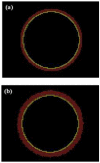Ensuring congruency in multiscale modeling: towards linking agent based and continuum biomechanical models of arterial adaptation
- PMID: 21809144
- PMCID: PMC3207323
- DOI: 10.1007/s10439-011-0363-9
Ensuring congruency in multiscale modeling: towards linking agent based and continuum biomechanical models of arterial adaptation
Abstract
There is a need to develop multiscale models of vascular adaptations to understand tissue-level manifestations of cellular level mechanisms. Continuum-based biomechanical models are well suited for relating blood pressures and flows to stress-mediated changes in geometry and properties, but less so for describing underlying mechanobiological processes. Discrete stochastic agent-based models are well suited for representing biological processes at a cellular level, but not for describing tissue-level mechanical changes. We present here a conceptually new approach to facilitate the coupling of continuum and agent-based models. Because of ubiquitous limitations in both the tissue- and cell-level data from which one derives constitutive relations for continuum models and rule-sets for agent-based models, we suggest that model verification should enforce congruency across scales. That is, multiscale model parameters initially determined from data sets representing different scales should be refined, when possible, to ensure that common outputs are consistent. Potential advantages of this approach are illustrated by comparing simulated aortic responses to a sustained increase in blood pressure predicted by continuum and agent-based models both before and after instituting a genetic algorithm to refine 16 objectively bounded model parameters. We show that congruency-based parameter refinement not only yielded increased consistency across scales, it also yielded predictions that are closer to in vivo observations.
Figures




Similar articles
-
Complementary vasoactivity and matrix remodelling in arterial adaptations to altered flow and pressure.J R Soc Interface. 2009 Mar 6;6(32):293-306. doi: 10.1098/rsif.2008.0254. J R Soc Interface. 2009. PMID: 18647735 Free PMC article.
-
A microstructurally motivated model of arterial wall mechanics with mechanobiological implications.Ann Biomed Eng. 2014 Mar;42(3):488-502. doi: 10.1007/s10439-013-0928-x. Epub 2013 Nov 7. Ann Biomed Eng. 2014. PMID: 24197802 Free PMC article.
-
Parameter sensitivity study of a constrained mixture model of arterial growth and remodeling.J Biomech Eng. 2009 Oct;131(10):101006. doi: 10.1115/1.3192144. J Biomech Eng. 2009. PMID: 19831476 Free PMC article.
-
Multiscale Computational Modeling of Vascular Adaptation: A Systems Biology Approach Using Agent-Based Models.Front Bioeng Biotechnol. 2021 Nov 2;9:744560. doi: 10.3389/fbioe.2021.744560. eCollection 2021. Front Bioeng Biotechnol. 2021. PMID: 34796166 Free PMC article. Review.
-
Review of the Techniques Used for Investigating the Role Elastin and Collagen Play in Arterial Wall Mechanics.IEEE Rev Biomed Eng. 2021;14:256-269. doi: 10.1109/RBME.2020.3005448. Epub 2021 Jan 22. IEEE Rev Biomed Eng. 2021. PMID: 32746366 Review.
Cited by
-
Extracellular matrix and the mechanics of large artery development.Biomech Model Mechanobiol. 2012 Nov;11(8):1169-86. doi: 10.1007/s10237-012-0405-8. Epub 2012 May 15. Biomech Model Mechanobiol. 2012. PMID: 22584609 Free PMC article.
-
A Systems Approach to Biomechanics, Mechanobiology, and Biotransport.J Biomech Eng. 2024 Apr 1;146(4):040801. doi: 10.1115/1.4064547. J Biomech Eng. 2024. PMID: 38270930 Free PMC article.
-
Models of signalling networks - what cell biologists can gain from them and give to them.J Cell Sci. 2013 May 1;126(Pt 9):1913-21. doi: 10.1242/jcs.112045. J Cell Sci. 2013. PMID: 23720376 Free PMC article. Review.
-
In Silico Tissue Engineering: A Coupled Agent-Based Finite Element Approach.Tissue Eng Part C Methods. 2019 Nov;25(11):641-654. doi: 10.1089/ten.TEC.2019.0103. Epub 2019 Sep 20. Tissue Eng Part C Methods. 2019. PMID: 31392930 Free PMC article.
-
Tuneable resolution as a systems biology approach for multi-scale, multi-compartment computational models.Wiley Interdiscip Rev Syst Biol Med. 2014 Jul-Aug;6(4):289-309. doi: 10.1002/wsbm.1270. Epub 2014 May 9. Wiley Interdiscip Rev Syst Biol Med. 2014. PMID: 24810243 Free PMC article. Review.
References
-
- Wolinsky H, Glagov S. A lamellar unit of aortic medial structure and function in mammals. Circ Res. 1967;20:99–111. - PubMed
-
- Langille BL. Remodeling of developing and mature arteries: endothelium, smooth muscle, and matrix. J Cardiovasc Pharmacol. 1993;21(Suppl 1):S11–17. - PubMed
-
- Lehoux S, Levy BI. Collateral artery growth: making the most of what you have. Circ Res. 2006;99:567–569. - PubMed
-
- Li S, Huang NF, Hsu S. Mechanotransduction in endothelial cell migration. J Cell Biochem. 2005;96:1110–1126. - PubMed
-
- Greve JM, Les AS, Tang BT, Draney Blomme MT, Wilson NM, Dalman RL, Pelc NJ, Taylor CA. Allometric scaling of wall shear stress from mice to humans: quantification using cine phase-contrast MRI and computational fluid dynamics. Am J Physiol Heart Circ Physiol. 2006;291:H1700–1708. - PubMed
Publication types
MeSH terms
Grants and funding
LinkOut - more resources
Full Text Sources
Other Literature Sources

